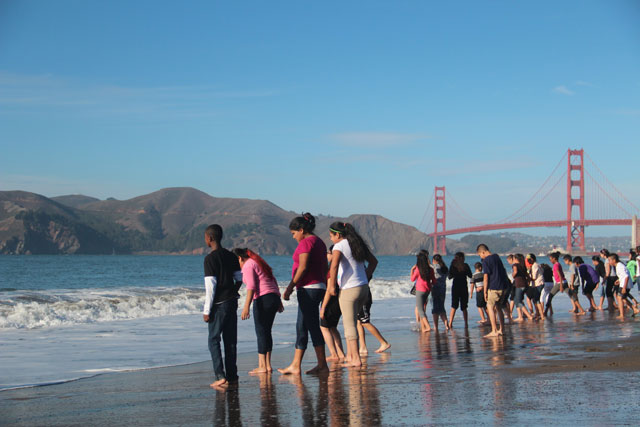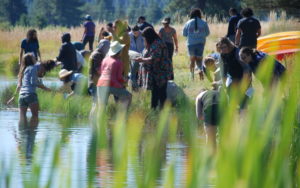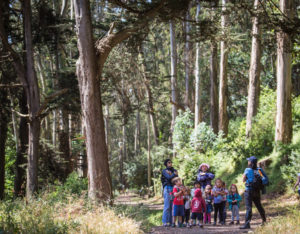The children, 6th graders from Urban Promise Academy (UPA), an Oakland middle school, were on a camping trip in the Presidio of San Francisco. The 52 students and their teachers had hiked down from their campground high on the hill above the beach.
Dotting the campground were piles of gear—tents, tarps, large bins of cookware, sleeping bags and large sacks full of warm clothing—all bearing the label “BAWT.”
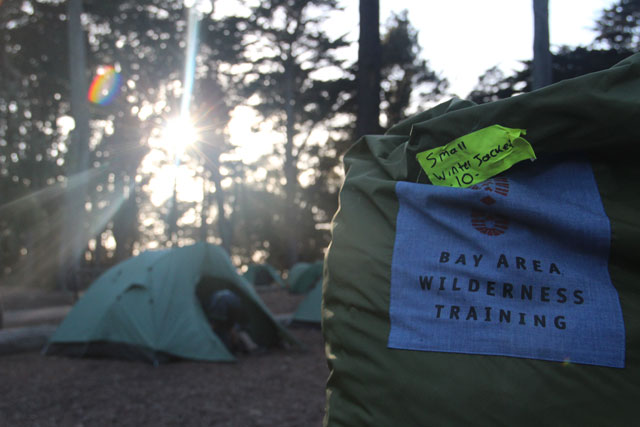
ay Area Wilderness Training (BAWT) is an Oakland-based project of the Earth Island Institute, and offers outdoor leadership training to teachers and youth workers. The program’s goal is to create opportunities for young people from the San Francisco Bay Area to experience wilderness firsthand. Along with training, BAWT operates several “gear libraries” stocked with outdoor equipment educators can borrow free of charge for their students. “We couldn’t do these trips without BAWT,” Urban Promises teacher Jill Johnson said.
Johnson participated in BAWT’s five-day Wilderness Leadership Training course with another Urban Promises teacher. “During training, I was able to experience what my students would experience,” Johnson said. “We role played different leadership styles, then we’d debriefed about what worked and what didn’t work. They were very strategic with every experience during our trip—they really emphasized developing the necessary skills that adults need to support youth in the outdoors.”
After the course, Johnson in turn used those tools and resources to develop WILD (Wilderness Independence and Leadership Development), Urban Promise’s first comprehensive outdoor program. Johnson said she designed the WILD program to give her students the same chance she’d had to learn and grow in the outdoors.
“My mom was a park ranger and she would take me to work,” Johnson said. “I grew up poor, without a lot. And being outside grounded me as a child. When I started teaching at UPA, I realized I wanted to be able to do the same thing for our students. They don’t have the same opportunities that some other kids do.”
Today, Urban Promises runs camping trips for all its students. By the end of the seventh week of the school year, every UPA student has gone on a camping trip. The WILD program emphasizes developing social and emotional skills, and trips involve learning how to use gear and set up camp, hiking, cooking, lessons on natural history and reflective journaling. “There’s no way that our relationship with our students could be built in the same way if we didn’t have time with them in the outdoors,” Johnson said. “You’re there for so many first moments for kids. It’s completely transformational.”
o support teachers in creating trips and learning experiences that are comfortable for the kids, Bay Area Wilderness Training relies on a train-the-trainer model—training the known and trusted educators within the community. “We say, ‘Who are the people who are already trusted, who are embedded in the community?’ Those are the people we train,” said Scott Wolland, BAWT’s executive director and chief executive officer.
This train-the-trainer model is rooted in the program’s mission to make outings culturally relevant by working with educators who understand the children’s values, community, and culture. “Leaders trying to reach minority communities have to understand the values and the connections that make the outdoors relevant to those communities,” said Nina Roberts, a professor in the department of Recreation, Parks and Tourism at San Francisco State.
Roberts has a PhD in parks and recreation and has studied the intersection of outdoor programming and leadership, youth development, culture and gender, in some capacity, for 30 years. “Everyone has a connection to the outdoors, we just don’t always know what it means to individuals and cultural groups,” she said. “So it’s not about understanding whether the outdoors is relevant, it’s about understanding how it’s relevant.
“For a long time some programs depended on a ‘Hoods in the Woods’ model,” Roberts continued, “where outdoor leaders would swoop in and say ‘We’re going to take your kids into nature and change their lives!’ Recreation and outdoor education leaders have begun to understand that in order to be successful you have build relationships with the people in the community you’re hoping to serve. You have to connect with the kids’ parents, teachers, and people they trust who understand their values and culture.”
In addition to providing cultural relevancy, the program’s train-the-trainer model allows students to process their experiences over time. “Lessons that are gleaned from the natural world percolate over time,” said Kyle Macdonald, the program’s founder. “You might not understand the depth of your learning for days or weeks or months or even years after you’ve had an experience in the outdoors. Kids need those learning experiences to be reinforced, guided and processed over time.”
Outdoor educator Jose Gonzalez, who founded Latino Outdoors to foster outdoor experiences across cultures, works closely with BAWT. “I think their model is: how can we best use our resources?” Gonzalez said. “How can we get the training and gear into the hands of the people who will be doing the best work with the students? We can combine what we’re good at—diversity and inclusion and community building.”
BAWT’s training model is designed to allow children to be comfortable with their leaders in the outdoors. “Youth workers who understand and relate to a child’s experience can build relationships on trust and care,” Gonzalez said. “It doesn’t matter if you have the best gear or the best outdoor curriculum, if you’re not also connecting on the social-emotional level. Youth don’t care how much you know until they know how much you care.”
roviding free rental gear is a cornerstone of BAWT’s program. Their gear libraries, inspired by the accessibility of public book lending libraries, have enough gear to outfit 350 people at once. “I wanted to call it a library because to me, libraries have always been always been one of the really special places,” Macdonald said. “It’s a shared public place where anyone can go to gain knowledge.”
The free gear has made outing trips possible for thousands of students. The Bay Area is famous for its access to the outdoors, but that access can come at a steep price. The cost of various pieces of equipment needed for a safe and comfortable outing —boots, fleece jackets, raincoats, tents, sleeping bags, camping stoves—can be prohibitive. “The gear libraries are what make this model successful and unique,” Macdonald said. “When you’re working with kids from poorer neighborhoods, you can’t just hand the parents a gear list and say ‘Buy this stuff.'”
The right gear can be the difference between a traumatic trip and positive, life-changing experience. “If you don’t have a rain jacket and it rains, you’re miserable,” Macdonald said. “But if have all the right gear and you’re warm and comfy, then it’s a blast.”
Armed with BAWT’s gear and outdoor expertise, Johnson and her fellow Urban Promise Academy teachers watch students discovering things about themselves in the natural world they might never learn in a classroom. “I think kids find their own strengths when they aren’t in a contained environment, like Oakland, or a structured environment, like school,” Johnson said.
“I think we’re approaching a tipping point of realizing that the standard playground and the no-risk model, the overprotection of children, can be restrictive. It’s not the best we can do to raise resilient, healthy children,” said Mary Roscoe, founder of the Children in Nature Collaborative, a network of people and organizations interested in providing children with access to the natural world.
“It’s really surprising to see how easily people hand technology to very young children these days,” Roscoe said. “I think that’s only going to increase. I think a hybrid picture, a balance, is the best model we can hope for. As much time as we spend with technology, we should spend an equal amount of time in nature.”
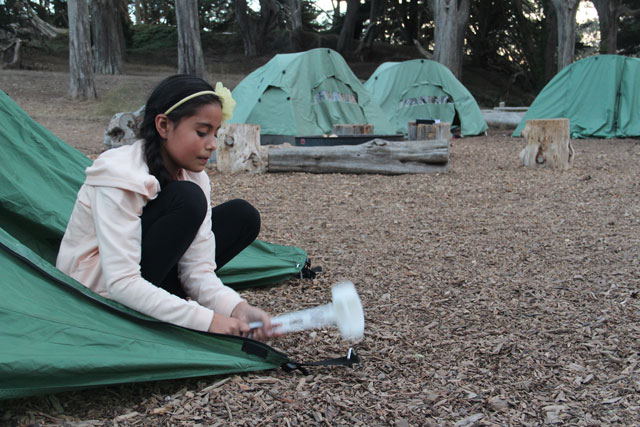
ack at Baker Beach, the students played in the shallow water along the shoreline, splashing their friends, writing their names in the sand, and searching for crabs. Before hiking back uphill to their campground, the students and teachers did a trash sweep, picking up old cans, bottles and plastic bags.
They finished their hike just as the sun dipped below the eucalyptus trees surrounding the campground. Several students helped their teachers prepare dinner, stirring chili, chopping vegetables for salad and setting out plates and silverware.
Across the campground Wendy Mejia, 12 years old, made sure her tent was secure by pounding the tent stakes into the ground with a plastic hammer. “I’m having so much fun,” she said. “The hike from the beach was pretty hard, but I love this nighttime part.”
As the sky darkened and the fog rolled in, the students disappeared into their tents to retrieve warm layers and flashlights before heading to the bonfire to roast s’mores.
On a bench nearby, 11-year-old Oscar Rodriguez tugged his Oakland Raiders wool hat down around his ears as he admired the sunset. “I like how the trees look when the sun is going down,” he said. “I’m so excited to sleep in a tent with my friends tonight.”
The UPA camping trip was part of the Camping at the Presidio Program managed by the Crissy Field Center (a collaboration with Bay Area Wilderness Training, the Presidio Trust, Golden Gate National Parks Conservancy, and the National Park Service). To find out more, visit http://www.parksconservancy.

